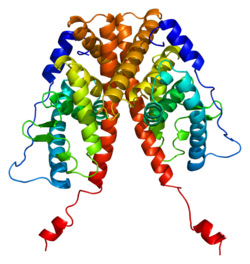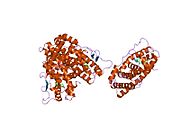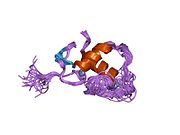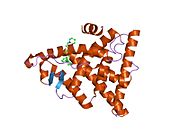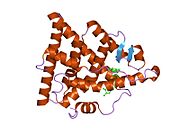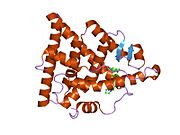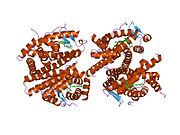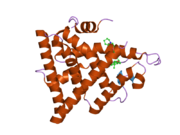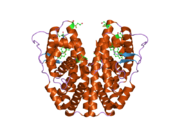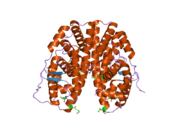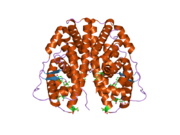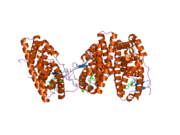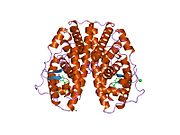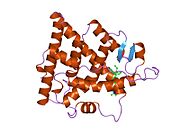ESR1
Estrogeni receptor alfa (ERα), znan i kao NR3A1 (član 1grupe A potporodice jedarnih receptora), jedan je od dva tipa estrogenih receptora, jedarni receptor koji se aktivira spolnim hormonom estrogenom. Kod ljudi kodiran genom ESR1 (Estrogeni receptor 1).[5][6][7]
Aminokiselinska sekvenca[uredi | uredi izvor]
Dužina polipeptidnog lanca je 595 aminokiselina, а molekulska težina 66.216 Da.[8]
| 10 | 20 | 30 | 40 | 50 | ||||
|---|---|---|---|---|---|---|---|---|
| MTMTLHTKAS | GMALLHQIQG | NELEPLNRPQ | LKIPLERPLG | EVYLDSSKPA | ||||
| VYNYPEGAAY | EFNAAAAANA | QVYGQTGLPY | GPGSEAAAFG | SNGLGGFPPL | ||||
| NSVSPSPLML | LHPPPQLSPF | LQPHGQQVPY | YLENEPSGYT | VREAGPPAFY | ||||
| RPNSDNRRQG | GRERLASTND | KGSMAMESAK | ETRYCAVCND | YASGYHYGVW | ||||
| SCEGCKAFFK | RSIQGHNDYM | CPATNQCTID | KNRRKSCQAC | RLRKCYEVGM | ||||
| MKGGIRKDRR | GGRMLKHKRQ | RDDGEGRGEV | GSAGDMRAAN | LWPSPLMIKR | ||||
| SKKNSLALSL | TADQMVSALL | DAEPPILYSE | YDPTRPFSEA | SMMGLLTNLA | ||||
| DRELVHMINW | AKRVPGFVDL | TLHDQVHLLE | CAWLEILMIG | LVWRSMEHPG | ||||
| KLLFAPNLLL | DRNQGKCVEG | MVEIFDMLLA | TSSRFRMMNL | QGEEFVCLKS | ||||
| IILLNSGVYT | FLSSTLKSLE | EKDHIHRVLD | KITDTLIHLM | AKAGLTLQQQ | ||||
| HQRLAQLLLI | LSHIRHMSNK | GMEHLYSMKC | KNVVPLYDLL | LEMLDAHRLH | ||||
| APTSRGGASV | EETDQSHLAT | AGSTSSHSLQ | KYYITGEAEG | FPATV |
Struktura[uredi | uredi izvor]
Receptor estrogena (ER) je ligand-aktivirani transkripcijski faktor sastavljen od nekoliko domena važnih za vezivanje hormona, vezanjem i aktivacijom transkripcije.[9] Alternativna prerada rezultira u nekoliko transkripata ESR1 iRNK, koji se prvenstveno razlikuju po pet primarnih neprevedenih regija (UTR5'). Translatirani receptori pokazuju manju varijabilnost.[10][11]
Ligandi[uredi | uredi izvor]
Agonisti[uredi | uredi izvor]
Neselektivni[uredi | uredi izvor]
- Endogeni estrogeni (npr. estradiol, estron, estriol, estetrol)
- prirodni estrogeni (npr. konjugirani konjski estrogeni)
- Sintetski estrogeni (npr. etinilestradiol, dietilstilbestrol)
Selektivni[uredi | uredi izvor]
Selektivni agonisti ERα u odnosu na ERβ uključuju:
- Propilpirazoletriol (PPT)
- 16α-LE2 (Cpd1471)
- 16α-IE2
- ERA-63 (ORG-37663)
- SKF-82.958 – također receptor sličan D1]potpuni agonist
- (R, R) -Tetrahidrohrisen, (R, R)-THC) – zapravo nije selektivan u odnosu na ERβ, već je antagonist umjesto agonista ERβ
Mješoviti[uredi | uredi izvor]
- Fitoestrogeni (npr. kumestrol, daidzein, genistein, miroestrol)
- Selektivni modulatori estrogenog eceptora (npr. tamoksifen, klomifen, raloksifen)
Antagonisti[uredi | uredi izvor]
Neselektivni[uredi | uredi izvor]
Selektivni[uredi | uredi izvor]
Selektivni antagonisti ERα u odnosu na ERβ uključuju:
- Metilpiperidinopirazol (MPP)
Afiniteti[uredi | uredi izvor]
Šablon:Afiniteti liganda estrogenog receptora ERα i ERβ
Tkivna distribucija i funkcija[uredi | uredi izvor]
ERα ima ulogu u fiziološkom razvoju i funkciji različitih organskih sistema u različitom stepenu, uključujući reproduktivni, centralni nervni, skeletni i kardiovaskularni sistem.[12] U skladu s tim, ERα je široko eksprimiran u cijelom tijelu, uključujući tkiva organa kao što su maternica i jajnici, muški reproduktivni organi, mliječne žlijezde, kosti, srce, hipotalamus, hipofiza, jetra, pluća, bubrezi, slezena i masno tkivo .[12][13][14] Razvoj i funkcija ovih tkiva poremećen je u životinjskim modelima bez aktivnih ERα gena, poput ERα nokaut-miša (ERKO), pružajući prethodno razumijevanje funkcije ERα u specifičnim ciljanim organima.[12][15]
Klinički značaj[uredi | uredi izvor]
Sindrom neosjetljivosti na estrogene je vrlo rijetko stanje koje karakterizira neispravan Erα, neosjetljiv na estrogene.[16][17][18][19] Uočeno je da klinička slika žena uključuje odsustvo razvoja dojke i drugih ženskih sekundarsnih spolnih obilježja u pubertetu, hipoplaziji maternice, primarnoj amenoreji, pri uvećanim policistastim jajnicima i pridruženom bolu u donjem dijelu trbuha, blagi hiperandrogenizam (ispoljava se kao cistaste akne) i odgođeno sazrijevanje kosti kao i povećana stopa koštanog promedta. Klinička slika kod mužjaka je uključivala nedostatak zatvaranja epifize, visok rast, osteoporozu i lošu održivost spermatozoida. Obje posmstrane osobe bile su potpuno neosetljive na egzogeni tretman estrogenom, čak i pri visokim dozama.
Genetički polimorfizmi u genu koji kodira ERα povezani su sa rakom dojke i dismenorejom kod žena, a ginekomastijom kod muškaraca.[20][21][22]
Koaktivatori[uredi | uredi izvor]
Koaktivatori ER-α uključuju:
- SRC-1[23][24]
- AIB1 – amplified in breast 1[25]
- BCAS3 – amplificirana sekvenca karcinoma dojke 3[26]
- PELP-1 – Prolinom-, glutamatom-, leucinom-bogati protein 1[27]
Interakcije[uredi | uredi izvor]
Pokazano je da receptor estrogena alfa stupa u interakcije sa:
- AKAP13[28]
- AHR[29][30]
- BRCA1[31][32][33][34]
- CAV1[35]
- CCNC[36]
- CDC25B[37]
- CEBPB[38][39]
- COBRA1[40]
- COUP-TFI[41]
- CREBBP[34][42]
- CRSP3[36]
- Ciklin D1[43]
- DDX17[44]
- DDX5[44][45]
- DNTTIP2[46]
- EP300[34][36][47]
- ESR2[48][49]
- FOXO1[50]
- GREB1[51]
- GTF2H1[52]
- HSP90AA1[53][54]
- ISL1[55]
- JARID1A[56]
- MVP[57]
- MED1[36][58]
- MED12[36]
- MED14[36]
- MED16[36]
- MED24[36][58]
- MED6[36]
- MGMT[59]
- MNAT1[60]
- MTA1[61][62]
- NCOA6[63][64]
- NCOA1[36][42][44][65][66]
- NCOA2[44][58][67][68][69]
- NCOA3[44][70][71]
- NRIP1[72][73][74]
- PDLIM1[75]
- POU4F1[76]
- POU4F2[76]
- PRDM2[77]
- PRMT2[78]
- RBM39[79]
- RNF12[75]
- SAFB[80][81]
- SAFB2[82]
- SHC1[83]
- SHP[84][85]
- SMARCA4[65][86]
- SMARCE1[87]
- SRA1[44]
- Src[59][88][89][90]
- TR2[91]
- TR4[92]
- TDG[93]
- TRIM24[73][94] i
- XBP1.[95]
Reference[uredi | uredi izvor]
- ^ a b c GRCh38: Ensembl release 89: ENSG00000091831 - Ensembl, maj 2017
- ^ a b c GRCm38: Ensembl release 89: ENSMUSG00000019768 - Ensembl, maj 2017
- ^ "Human PubMed Reference:". National Center for Biotechnology Information, U.S. National Library of Medicine.
- ^ "Mouse PubMed Reference:". National Center for Biotechnology Information, U.S. National Library of Medicine.
- ^ "Entrez Gene: ESR1 estrogen receptor 1".
- ^ Walter P, Green S, Greene G, Krust A, Bornert JM, Jeltsch JM, Staub A, Jensen E, Scrace G, Waterfield M (decembar 1985). "Cloning of the human estrogen receptor cDNA". Proc. Natl. Acad. Sci. U.S.A. 82 (23): 7889–93. Bibcode:1985PNAS...82.7889W. doi:10.1073/pnas.82.23.7889. PMC 390875. PMID 3865204.
- ^ Greene GL, Gilna P, Waterfield M, Baker A, Hort Y, Shine J (mart 1986). "Sequence and expression of human estrogen receptor complementary DNA". Science. 231 (4742): 1150–4. Bibcode:1986Sci...231.1150G. doi:10.1126/science.3753802. PMID 3753802.
- ^ "UniProt, P03372" (jezik: engleski). Pristupljeno 7. 10. 2021.
- ^ Dahlman-Wright K, Cavailles V, Fuqua SA, Jordan VC, Katzenellenbogen JA, Korach KS, Maggi A, Muramatsu M, Parker MG, Gustafsson JA (decembar 2006). "International Union of Pharmacology. LXIV. Estrogen receptors". Pharmacol. Rev. 58 (4): 773–81. doi:10.1124/pr.58.4.8. PMID 17132854. S2CID 45996586.
- ^ "Entrez Gene: DBI diazepam binding inhibitor (GABA receptor modulator, acyl-Coenzyme A binding protein)".
- ^ Kos M, Reid G, Denger S, Gannon F (decembar 2001). "Minireview: genomic organization of the human ERalpha gene promoter region". Mol. Endocrinol. 15 (12): 2057–63. doi:10.1210/me.15.12.2057. PMID 11731608.
- ^ a b c Bondesson M, Hao R, Lin CY, Williams C, Gustafsson JÅ (februar 2015). "Estrogen receptor signaling during vertebrate development". Biochimica et Biophysica Acta (BBA) - Gene Regulatory Mechanisms. 1849 (2): 142–51. doi:10.1016/j.bbagrm.2014.06.005. PMC 4269570. PMID 24954179.
- ^ Curtis Hewitt S, Couse JF, Korach KS (2000). "Estrogen receptor transcription and transactivation: Estrogen receptor knockout mice: what their phenotypes reveal about mechanisms of estrogen action". Breast Cancer Research. 2 (5): 345–52. doi:10.1186/bcr79. PMC 138656. PMID 11250727.
- ^ Paterni I, Granchi C, Katzenellenbogen JA, Minutolo F (novembar 2014). "Estrogen receptors alpha (ERα) and beta (ERβ): subtype-selective ligands and clinical potential". Steroids. 90: 13–29. doi:10.1016/j.steroids.2014.06.012. PMC 4192010. PMID 24971815.
- ^ Lee HR, Kim TH, Choi KC (juni 2012). "Functions and physiological roles of two types of estrogen receptors, ERα and ERβ, identified by estrogen receptor knockout mouse". Laboratory Animal Research. 28 (2): 71–6. doi:10.5625/lar.2012.28.2.71. PMC 3389841. PMID 22787479.
- ^ Jameson JL, De Groot LJ (februar 2015). Endocrinology: Adult and Pediatric. Elsevier Health Sciences. str. 238–. ISBN 978-0-323-32195-2.
- ^ Korach KS, Couse JF, Curtis SW, Washburn TF, Lindzey J, Kimbro KS, Eddy EM, Migliaccio S, Snedeker SM, Lubahn DB, Schomberg DW, Smith EP (1996). "Estrogen receptor gene disruption: molecular characterization and experimental and clinical phenotypes". Recent Progress in Hormone Research. 51: 159–86, discussion 186–8. PMID 8701078.
- ^ Smith EP, Boyd J, Frank GR, Takahashi H, Cohen RM, Specker B, Williams TC, Lubahn DB, Korach KS (Oct 1994). "Estrogen resistance caused by a mutation in the estrogen-receptor gene in a man". The New England Journal of Medicine. 331 (16): 1056–61. doi:10.1056/NEJM199410203311604. PMID 8090165.
- ^ Quaynor SD, Stradtman EW, Kim HG, Shen Y, Chorich LP, Schreihofer DA, Layman LC (Jul 2013). "Delayed puberty and estrogen resistance in a woman with estrogen receptor α variant". The New England Journal of Medicine. 369 (2): 164–71. doi:10.1056/NEJMoa1303611. PMC 3823379. PMID 23841731.
- ^ Jahandoost S, Farhanghian P, Abbasi S (2017). "The Effects of Sex Protein Receptors and Sex Steroid Hormone Gene Polymorphisms on Breast Cancer Risk". J Natl Med Assoc. 109 (2): 126–138. doi:10.1016/j.jnma.2017.02.003. PMID 28599754.
- ^ Eren E, Edgunlu T, Korkmaz HA, Cakir ED, Demir K, Cetin ES, Celik SK (2014). "Genetic variants of estrogen beta and leptin receptors may cause gynecomastia in adolescent". Gene. 541 (2): 101–6. doi:10.1016/j.gene.2014.03.013. PMID 24625355.
- ^ Woo HY, Kim KH, Lim SW (2009). "Estrogen receptor 1, glutathione S-transferase P1, glutathione S-transferase M1, and glutathione S-transferase T1 genes with dysmenorrhea in Korean female adolescents". Korean J Lab Med. 30 (1): 76–83. doi:10.3343/kjlm.2010.30.1.76. PMID 20197727.
- ^ Shang Y, Brown M (2002). "Molecular determinants for the tissue specificity of SERMs". Science. 295 (5564): 2465–8. Bibcode:2002Sci...295.2465S. doi:10.1126/science.1068537. PMID 11923541. S2CID 30634073.
- ^ Smith CL, O'Malley BW (2004). "Coregulator function: a key to understanding tissue specificity of selective receptor modulators". Endocr Rev. 25 (1): 45–71. doi:10.1210/er.2003-0023. PMID 14769827.
- ^ Anzick SL, Kononen J, Walker RL, Azorsa DO, Tanner MM, Guan XY, Sauter G, Kallioniemi OP, Trent JM, Meltzer PS (1997). "AIB1, a steroid receptor coactivator amplified in breast and ovarian cancer". Science. 277 (5328): 965–8. doi:10.1126/science.277.5328.965. PMID 9252329.
- ^ Gururaj AE, Peng S, Vadlamudi RK, Kumar R (august 2007). "Estrogen induces expression of BCAS3, a novel estrogen receptor-alpha coactivator, through proline-, glutamic acid-, and leucine-rich protein-1 (PELP1)". Mol. Endocrinol. 21 (8): 1847–60. doi:10.1210/me.2006-0514. PMID 17505058.
- ^ Vadlamudi RK, Wang RA, Mazumdar A, Kim Y, Shin J, Sahin A, Kumar R (2001). "Molecular cloning and characterization of PELP1, a novel human coregulator of estrogen receptor alpha". J. Biol. Chem. 276 (41): 38272–9. doi:10.1074/jbc.M103783200. PMID 11481323.
- ^ Rubino D, Driggers P, Arbit D, Kemp L, Miller B, Coso O, Pagliai K, Gray K, Gutkind S, Segars J (maj 1998). "Characterization of Brx, a novel Dbl family member that modulates estrogen receptor action". Oncogene. 16 (19): 2513–26. doi:10.1038/sj.onc.1201783. PMID 9627117. S2CID 20906586.
- ^ Wormke M, Stoner M, Saville B, Walker K, Abdelrahim M, Burghardt R, Safe S (Mar 2003). "The Aryl Hydrocarbon Receptor Mediates Degradation of Estrogen Receptor α through Activation of Proteasomes". Mol. Cell. Biol. 23 (6): 1843–55. doi:10.1128/MCB.23.6.1843-1855.2003. PMC 149455. PMID 12612060.
- ^ Klinge CM, Kaur K, Swanson HI (Jan 2000). "The aryl hydrocarbon receptor interacts with estrogen receptor alpha and orphan receptors COUP-TFI and ERRalpha1". Arch. Biochem. Biophys. 373 (1): 163–74. doi:10.1006/abbi.1999.1552. PMID 10620335.
- ^ Zheng L, Annab LA, Afshari CA, Lee WH, Boyer TG (Aug 2001). "BRCA1 mediates ligand-independent transcriptional repression of the estrogen receptor". Proc. Natl. Acad. Sci. U.S.A. 98 (17): 9587–92. Bibcode:2001PNAS...98.9587Z. doi:10.1073/pnas.171174298. PMC 55496. PMID 11493692.
- ^ Fan S, Ma YX, Wang C, Yuan RQ, Meng Q, Wang JA, Erdos M, Goldberg ID, Webb P, Kushner PJ, Pestell RG, Rosen EM (Jan 2001). "Role of direct interaction in BRCA1 inhibition of estrogen receptor activity". Oncogene. 20 (1): 77–87. doi:10.1038/sj.onc.1204073. PMID 11244506. S2CID 24657209.
- ^ Kawai H, Li H, Chun P, Avraham S, Avraham HK (Oct 2002). "Direct interaction between BRCA1 and the estrogen receptor regulates vascular endothelial growth factor (VEGF) transcription and secretion in breast cancer cells". Oncogene. 21 (50): 7730–9. doi:10.1038/sj.onc.1205971. PMID 12400015. S2CID 32740995.
- ^ a b c Fan S, Ma YX, Wang C, Yuan RQ, Meng Q, Wang JA, Erdos M, Goldberg ID, Webb P, Kushner PJ, Pestell RG, Rosen EM (Jan 2002). "p300 Modulates the BRCA1 inhibition of estrogen receptor activity". Cancer Res. 62 (1): 141–51. PMID 11782371.
- ^ Schlegel A, Wang C, Pestell RG, Lisanti MP (Oct 2001). "Ligand-independent activation of oestrogen receptor alpha by caveolin-1". Biochem. J. 359 (Pt 1): 203–10. doi:10.1042/0264-6021:3590203. PMC 1222136. PMID 11563984.
- ^ a b c d e f g h i j Kang YK, Guermah M, Yuan CX, Roeder RG (Mar 2002). "The TRAP/Mediator coactivator complex interacts directly with estrogen receptors α and β through the TRAP220 subunit and directly enhances estrogen receptor function in vitro". Proc. Natl. Acad. Sci. U.S.A. 99 (5): 2642–7. Bibcode:2002PNAS...99.2642K. doi:10.1073/pnas.261715899. PMC 122401. PMID 11867769.
- ^ Ma ZQ, Liu Z, Ngan ES, Tsai SY (Dec 2001). "Cdc25B Functions as a Novel Coactivator for the Steroid Receptors". Mol. Cell. Biol. 21 (23): 8056–67. doi:10.1128/MCB.21.23.8056-8067.2001. PMC 99972. PMID 11689696.
- ^ Boruk M, Savory JG, Haché RJ (Nov 1998). "AF-2-dependent potentiation of CCAAT enhancer binding protein beta-mediated transcriptional activation by glucocorticoid receptor". Mol. Endocrinol. 12 (11): 1749–63. doi:10.1210/mend.12.11.0191. PMID 9817600.
- ^ Stein B, Yang MX (Sep 1995). "Repression of the interleukin-6 promoter by estrogen receptor is mediated by NF-kappa B and C/EBP beta". Mol. Cell. Biol. 15 (9): 4971–9. doi:10.1128/MCB.15.9.4971. PMC 230744. PMID 7651415.
- ^ Aiyar SE, Sun JL, Blair AL, Moskaluk CA, Lu YZ, Ye QN, Yamaguchi Y, Mukherjee A, Ren DM, Handa H, Li R (Sep 2004). "Attenuation of estrogen receptor α-mediated transcription through estrogen-stimulated recruitment of a negative elongation factor". Genes Dev. 18 (17): 2134–46. doi:10.1101/gad.1214104. PMC 515291. PMID 15342491.
- ^ Métivier R, Gay FA, Hübner MR, Flouriot G, Salbert G, Gannon F, Kah O, Pakdel F (Jul 2002). "Formation of an hERα–COUP-TFI complex enhances hERα AF-1 through Ser118 phosphorylation by MAPK". EMBO J. 21 (13): 3443–53. doi:10.1093/emboj/cdf344. PMC 126093. PMID 12093745.
- ^ a b Sheppard HM, Harries JC, Hussain S, Bevan C, Heery DM (Jan 2001). "Analysis of the Steroid Receptor Coactivator 1 (SRC1)-CREB Binding Protein Interaction Interface and Its Importance for the Function of SRC1". Mol. Cell. Biol. 21 (1): 39–50. doi:10.1128/MCB.21.1.39-50.2001. PMC 86566. PMID 11113179.
- ^ Zwijsen RM, Wientjens E, Klompmaker R, van der Sman J, Bernards R, Michalides RJ (Feb 1997). "CDK-independent activation of estrogen receptor by cyclin D1". Cell. 88 (3): 405–15. doi:10.1016/S0092-8674(00)81879-6. hdl:1874/21074. PMID 9039267. S2CID 16492666.
- ^ a b c d e f Watanabe M, Yanagisawa J, Kitagawa H, Takeyama K, Ogawa S, Arao Y, Suzawa M, Kobayashi Y, Yano T, Yoshikawa H, Masuhiro Y, Kato S (Mar 2001). "A subfamily of RNA-binding DEAD-box proteins acts as an estrogen receptor α coactivator through the N-terminal activation domain (AF-1) with an RNA coactivator, SRA". EMBO J. 20 (6): 1341–52. doi:10.1093/emboj/20.6.1341. PMC 145523. PMID 11250900.
- ^ Endoh H, Maruyama K, Masuhiro Y, Kobayashi Y, Goto M, Tai H, Yanagisawa J, Metzger D, Hashimoto S, Kato S (Aug 1999). "Purification and Identification of p68 RNA Helicase Acting as a Transcriptional Coactivator Specific for the Activation Function 1 of Human Estrogen Receptor α". Mol. Cell. Biol. 19 (8): 5363–72. doi:10.1128/MCB.19.8.5363. PMC 84379. PMID 10409727.
- ^ Bu H, Kashireddy P, Chang J, Zhu YT, Zhang Z, Zheng W, Rao SM, Zhu YJ (Apr 2004). "ERBP, a novel estrogen receptor binding protein enhancing the activity of estrogen receptor". Biochem. Biophys. Res. Commun. 317 (1): 54–9. doi:10.1016/j.bbrc.2004.02.179. ISSN 0006-291X. PMID 15047147.
- ^ Fajas L, Egler V, Reiter R, Hansen J, Kristiansen K, Debril MB, Miard S, Auwerx J (Dec 2002). "The retinoblastoma-histone deacetylase 3 complex inhibits PPARgamma and adipocyte differentiation". Dev. Cell. 3 (6): 903–10. doi:10.1016/S1534-5807(02)00360-X. PMID 12479814.
- ^ Ogawa S, Inoue S, Watanabe T, Hiroi H, Orimo A, Hosoi T, Ouchi Y, Muramatsu M (Feb 1998). "The complete primary structure of human estrogen receptor beta (hER beta) and its heterodimerization with ER alpha in vivo and in vitro". Biochem. Biophys. Res. Commun. 243 (1): 122–6. doi:10.1006/bbrc.1997.7893. ISSN 0006-291X. PMID 9473491.
- ^ Poelzl G, Kasai Y, Mochizuki N, Shaul PW, Brown M, Mendelsohn ME (Mar 2000). "Specific association of estrogen receptor β with the cell cycle spindle assembly checkpoint protein, MAD2". Proc. Natl. Acad. Sci. U.S.A. 97 (6): 2836–9. Bibcode:2000PNAS...97.2836P. doi:10.1073/pnas.050580997. PMC 16016. PMID 10706629.
- ^ Schuur ER, Loktev AV, Sharma M, Sun Z, Roth RA, Weigel RJ (Sep 2001). "Ligand-dependent interaction of estrogen receptor-alpha with members of the forkhead transcription factor family". J. Biol. Chem. 276 (36): 33554–60. doi:10.1074/jbc.M105555200. PMID 11435445. S2CID 11652289.
- ^ Deschênes J, Bourdeau V, White JH, Mader S (juni 2007). "Regulation of GREB1 transcription by estrogen receptor alpha through a multipartite enhancer spread over 20 kb of upstream flanking sequences". J. Biol. Chem. 282 (24): 17335–17339. doi:10.1074/jbc.C700030200. PMID 17463000. S2CID 24262059.
- ^ Chen D, Riedl T, Washbrook E, Pace PE, Coombes RC, Egly JM, Ali S (Jul 2000). "Activation of estrogen receptor alpha by S118 phosphorylation involves a ligand-dependent interaction with TFIIH and participation of CDK7". Mol. Cell. 6 (1): 127–37. doi:10.1016/S1097-2765(00)00014-9. PMID 10949034.
- ^ Nair SC, Toran EJ, Rimerman RA, Hjermstad S, Smithgall TE, Smith DF (Dec 1996). "A pathway of multi-chaperone interactions common to diverse regulatory proteins: estrogen receptor, Fes tyrosine kinase, heat shock transcription factor Hsf1, and the aryl hydrocarbon receptor". Cell Stress Chaperones. 1 (4): 237–50. doi:10.1379/1466-1268(1996)001<0237:APOMCI>2.3.CO;2. PMC 376461. PMID 9222609.
- ^ Lee MO, Kim EO, Kwon HJ, Kim YM, Kang HJ, Kang H, Lee JE (Feb 2002). "Radicicol represses the transcriptional function of the estrogen receptor by suppressing the stabilization of the receptor by heat shock protein 90". Mol. Cell. Endocrinol. 188 (1–2): 47–54. doi:10.1016/S0303-7207(01)00753-5. PMID 11911945. S2CID 37933406.
- ^ Gay F, Anglade I, Gong Z, Salbert G (Oct 2000). "The LIM/homeodomain protein islet-1 modulates estrogen receptor functions". Mol. Endocrinol. 14 (10): 1627–48. doi:10.1210/me.14.10.1627. PMID 11043578.
- ^ Chan SW, Hong W (Jul 2001). "Retinoblastoma-binding protein 2 (Rbp2) potentiates nuclear hormone receptor-mediated transcription". J. Biol. Chem. 276 (30): 28402–12. doi:10.1074/jbc.M100313200. PMID 11358960. S2CID 22993127.
- ^ Abbondanza C, Rossi V, Roscigno A, Gallo L, Belsito A, Piluso G, Medici N, Nigro V, Molinari AM, Moncharmont B, Puca GA (Jun 1998). "Interaction of Vault Particles with Estrogen Receptor in the MCF-7 Breast Cancer Cell". J. Cell Biol. 141 (6): 1301–10. doi:10.1083/jcb.141.6.1301. PMC 2132791. PMID 9628887.
- ^ a b c Kitagawa H, Fujiki R, Yoshimura K, Mezaki Y, Uematsu Y, Matsui D, Ogawa S, Unno K, Okubo M, Tokita A, Nakagawa T, Ito T, Ishimi Y, Nagasawa H, Matsumoto T, Yanagisawa J, Kato S (Jun 2003). "The chromatin-remodeling complex WINAC targets a nuclear receptor to promoters and is impaired in Williams syndrome". Cell. 113 (7): 905–17. doi:10.1016/S0092-8674(03)00436-7. PMID 12837248. S2CID 18686879.
- ^ a b Teo AK, Oh HK, Ali RB, Li BF (Oct 2001). "The Modified Human DNA Repair Enzyme O6-Methylguanine-DNA Methyltransferase Is a Negative Regulator of Estrogen Receptor-Mediated Transcription upon Alkylation DNA Damage". Mol. Cell. Biol. 21 (20): 7105–14. doi:10.1128/MCB.21.20.7105-7114.2001. PMC 99886. PMID 11564893.
- ^ Talukder AH, Mishra SK, Mandal M, Balasenthil S, Mehta S, Sahin AA, Barnes CJ, Kumar R (Mar 2003). "MTA1 interacts with MAT1, a cyclin-dependent kinase-activating kinase complex ring finger factor, and regulates estrogen receptor transactivation functions". J. Biol. Chem. 278 (13): 11676–85. doi:10.1074/jbc.M209570200. PMID 12527756. S2CID 25527041.
- ^ Kumar R, Wang RA, Mazumdar A, Talukder AH, Mandal M, Yang Z, Bagheri-Yarmand R, Sahin A, Hortobagyi G, Adam L, Barnes CJ, Vadlamudi RK (Aug 2002). "A naturally occurring MTA1 variant sequesters oestrogen receptor-alpha in the cytoplasm". Nature. 418 (6898): 654–7. Bibcode:2002Natur.418..654K. doi:10.1038/nature00889. PMID 12167865. S2CID 4355677.
- ^ Mazumdar A, Wang RA, Mishra SK, Adam L, Bagheri-Yarmand R, Mandal M, Vadlamudi RK, Kumar R (Jan 2001). "Transcriptional repression of oestrogen receptor by metastasis-associated protein 1 corepressor". Nat. Cell Biol. 3 (1): 30–7. doi:10.1038/35050532. PMID 11146623. S2CID 23477845.
- ^ Lee SK, Anzick SL, Choi JE, Bubendorf L, Guan XY, Jung YK, Kallioniemi OP, Kononen J, Trent JM, Azorsa D, Jhun BH, Cheong JH, Lee YC, Meltzer PS, Lee JW (Nov 1999). "A nuclear factor, ASC-2, as a cancer-amplified transcriptional coactivator essential for ligand-dependent transactivation by nuclear receptors in vivo". J. Biol. Chem. 274 (48): 34283–93. doi:10.1074/jbc.274.48.34283. PMID 10567404. S2CID 36982011.
- ^ Ko L, Cardona GR, Iwasaki T, Bramlett KS, Burris TP, Chin WW (Jan 2002). "Ser-884 adjacent to the LXXLL motif of coactivator TRBP defines selectivity for ERs and TRs". Mol. Endocrinol. 16 (1): 128–40. doi:10.1210/mend.16.1.0755. PMID 11773444.
- ^ a b DiRenzo J, Shang Y, Phelan M, Sif S, Myers M, Kingston R, Brown M (Oct 2000). "BRG-1 Is Recruited to Estrogen-Responsive Promoters and Cooperates with Factors Involved in Histone Acetylation". Mol. Cell. Biol. 20 (20): 7541–9. doi:10.1128/MCB.20.20.7541-7549.2000. PMC 86306. PMID 11003650.
- ^ Kalkhoven E, Valentine JE, Heery DM, Parker MG (Jan 1998). "Isoforms of steroid receptor co-activator 1 differ in their ability to potentiate transcription by the oestrogen receptor". EMBO J. 17 (1): 232–43. doi:10.1093/emboj/17.1.232. PMC 1170374. PMID 9427757.
- ^ Wärnmark A, Treuter E, Gustafsson JA, Hubbard RE, Brzozowski AM, Pike AC (Jun 2002). "Interaction of transcriptional intermediary factor 2 nuclear receptor box peptides with the coactivator binding site of estrogen receptor alpha". J. Biol. Chem. 277 (24): 21862–8. doi:10.1074/jbc.M200764200. PMID 11937504. S2CID 45251979.
- ^ He B, Wilson EM (Mar 2003). "Electrostatic Modulation in Steroid Receptor Recruitment of LXXLL and FXXLF Motifs". Mol. Cell. Biol. 23 (6): 2135–50. doi:10.1128/MCB.23.6.2135-2150.2003. PMC 149467. PMID 12612084.
- ^ Fenne IS, Hoang T, Hauglid M, Sagen JV, Lien EA, Mellgren G (Sep 2008). "Recruitment of coactivator glucocorticoid receptor interacting protein 1 to an estrogen receptor transcription complex is regulated by the 3',5'-cyclic adenosine 5'-monophosphate-dependent protein kinase". Endocrinology. 149 (9): 4336–45. doi:10.1210/en.2008-0037. PMID 18499756.
- ^ Wong CW, Komm B, Cheskis BJ (Jun 2001). "Structure-function evaluation of ER alpha and beta interplay with SRC family coactivators. ER selective ligands". Biochemistry. 40 (23): 6756–65. doi:10.1021/bi010379h. PMID 11389589.
- ^ Tikkanen MK, Carter DJ, Harris AM, Le HM, Azorsa DO, Meltzer PS, Murdoch FE (Nov 2000). "Endogenously expressed estrogen receptor and coactivator AIB1 interact in MCF-7 human breast cancer cells". Proc. Natl. Acad. Sci. U.S.A. 97 (23): 12536–40. Bibcode:2000PNAS...9712536T. doi:10.1073/pnas.220427297. PMC 18799. PMID 11050174.
- ^ Cavaillès V, Dauvois S, L'Horset F, Lopez G, Hoare S, Kushner PJ, Parker MG (Aug 1995). "Nuclear factor RIP140 modulates transcriptional activation by the estrogen receptor". EMBO J. 14 (15): 3741–51. doi:10.1002/j.1460-2075.1995.tb00044.x. PMC 394449. PMID 7641693.
- ^ a b Thénot S, Henriquet C, Rochefort H, Cavaillès V (maj 1997). "Differential interaction of nuclear receptors with the putative human transcriptional coactivator hTIF1". J. Biol. Chem. 272 (18): 12062–8. doi:10.1074/jbc.272.18.12062. PMID 9115274. S2CID 32098587.
- ^ L'Horset F, Dauvois S, Heery DM, Cavaillès V, Parker MG (Nov 1996). "RIP-140 interacts with multiple nuclear receptors by means of two distinct sites". Mol. Cell. Biol. 16 (11): 6029–36. doi:10.1128/MCB.16.11.6029. PMC 231605. PMID 8887632.
- ^ a b Johnsen SA, Güngör C, Prenzel T, Riethdorf S, Riethdorf L, Taniguchi-Ishigaki N, Rau T, Tursun B, Furlow JD, Sauter G, Scheffner M, Pantel K, Gannon F, Bach I (Jan 2009). "Regulation of Estrogen-Dependent Transcription by the LIM Cofactors CLIM and RLIM in Breast Cancer". Cancer Res. 69 (1): 128–36. doi:10.1158/0008-5472.CAN-08-1630. PMC 2713826. PMID 19117995.
- ^ a b Budhram-Mahadeo V, Parker M, Latchman DS (Feb 1998). "POU Transcription Factors Brn-3a and Brn-3b Interact with the Estrogen Receptor and Differentially Regulate Transcriptional Activity via an Estrogen Response Element". Mol. Cell. Biol. 18 (2): 1029–41. doi:10.1128/mcb.18.2.1029. PMC 108815. PMID 9448000.
- ^ Abbondanza C, Medici N, Nigro V, Rossi V, Gallo L, Piluso G, Belsito A, Roscigno A, Bontempo P, Puca AA, Molinari AM, Moncharmont B, Puca GA (Mar 2000). "The retinoblastoma-interacting zinc-finger protein RIZ is a downstream effector of estrogen action". Proc. Natl. Acad. Sci. U.S.A. 97 (7): 3130–5. doi:10.1073/pnas.050015697. PMC 16204. PMID 10706618.
- ^ Qi C, Chang J, Zhu Y, Yeldandi AV, Rao SM, Zhu YJ (Aug 2002). "Identification of protein arginine methyltransferase 2 as a coactivator for estrogen receptor alpha". J. Biol. Chem. 277 (32): 28624–30. doi:10.1074/jbc.M201053200. PMID 12039952. S2CID 25844266.
- ^ Jung DJ, Na SY, Na DS, Lee JW (Jan 2002). "Molecular cloning and characterization of CAPER, a novel coactivator of activating protein-1 and estrogen receptors". J. Biol. Chem. 277 (2): 1229–34. doi:10.1074/jbc.M110417200. PMID 11704680. S2CID 39443808.
- ^ Townson SM, Kang K, Lee AV, Oesterreich S (Jun 2004). "Structure-function analysis of the estrogen receptor alpha corepressor scaffold attachment factor-B1: identification of a potent transcriptional repression domain". J. Biol. Chem. 279 (25): 26074–81. doi:10.1074/jbc.M313726200. PMID 15066997.
- ^ Oesterreich S, Zhang Q, Hopp T, Fuqua SA, Michaelis M, Zhao HH, Davie JR, Osborne CK, Lee AV (Mar 2000). "Tamoxifen-bound estrogen receptor (ER) strongly interacts with the nuclear matrix protein HET/SAF-B, a novel inhibitor of ER-mediated transactivation". Mol. Endocrinol. 14 (3): 369–81. doi:10.1210/mend.14.3.0432. PMID 10707955.
- ^ Townson SM, Dobrzycka KM, Lee AV, Air M, Deng W, Kang K, Jiang S, Kioka N, Michaelis K, Oesterreich S (maj 2003). "SAFB2, a new scaffold attachment factor homolog and estrogen receptor corepressor". J. Biol. Chem. 278 (22): 20059–68. doi:10.1074/jbc.M212988200. PMID 12660241. S2CID 36827119.
- ^ Song RX, McPherson RA, Adam L, Bao Y, Shupnik M, Kumar R, Santen RJ (Jan 2002). "Linkage of rapid estrogen action to MAPK activation by ERalpha-Shc association and Shc pathway activation". Mol. Endocrinol. 16 (1): 116–27. doi:10.1210/me.16.1.116. PMID 11773443.
- ^ Seol W, Hanstein B, Brown M, Moore DD (Oct 1998). "Inhibition of estrogen receptor action by the orphan receptor SHP (short heterodimer partner)". Mol. Endocrinol. 12 (10): 1551–7. doi:10.1210/me.12.10.1551. PMID 9773978.
- ^ Klinge CM, Jernigan SC, Risinger KE (Mar 2002). "The agonist activity of tamoxifen is inhibited by the short heterodimer partner orphan nuclear receptor in human endometrial cancer cells". Endocrinology. 143 (3): 853–67. doi:10.1210/en.143.3.853. PMID 11861507.
- ^ Ichinose H, Garnier JM, Chambon P, Losson R (Mar 1997). "Ligand-dependent interaction between the estrogen receptor and the human homologues of SWI2/SNF2". Gene. 188 (1): 95–100. doi:10.1016/S0378-1119(96)00785-8. PMID 9099865.
- ^ Belandia B, Orford RL, Hurst HC, Parker MG (Aug 2002). "Targeting of SWI/SNF chromatin remodelling complexes to estrogen-responsive genes". EMBO J. 21 (15): 4094–103. doi:10.1093/emboj/cdf412. PMC 126156. PMID 12145209.
- ^ Migliaccio A, Castoria G, Di Domenico M, de Falco A, Bilancio A, Lombardi M, Barone MV, Ametrano D, Zannini MS, Abbondanza C, Auricchio F (Oct 2000). "Steroid-induced androgen receptor–oestradiol receptor β–Src complex triggers prostate cancer cell proliferation". EMBO J. 19 (20): 5406–17. doi:10.1093/emboj/19.20.5406. PMC 314017. PMID 11032808.
- ^ Kim HJ, Yi JY, Sung HS, Moore DD, Jhun BH, Lee YC, Lee JW (Sep 1999). "Activating Signal Cointegrator 1, a Novel Transcription Coactivator of Nuclear Receptors, and Its Cytosolic Localization under Conditions of Serum Deprivation". Mol. Cell. Biol. 19 (9): 6323–32. doi:10.1128/mcb.19.9.6323. PMC 84603. PMID 10454579.
- ^ Slentz-Kesler K, Moore JT, Lombard M, Zhang J, Hollingsworth R, Weiner MP (Oct 2000). "Identification of the human Mnk2 gene (MKNK2) through protein interaction with estrogen receptor beta". Genomics. 69 (1): 63–71. doi:10.1006/geno.2000.6299. PMID 11013076.
- ^ Hu YC, Shyr CR, Che W, Mu XM, Kim E, Chang C (Sep 2002). "Suppression of estrogen receptor-mediated transcription and cell growth by interaction with TR2 orphan receptor". J. Biol. Chem. 277 (37): 33571–9. doi:10.1074/jbc.M203531200. PMID 12093804. S2CID 21803067.
- ^ Shyr CR, Hu YC, Kim E, Chang C (Apr 2002). "Modulation of estrogen receptor-mediated transactivation by orphan receptor TR4 in MCF-7 cells". J. Biol. Chem. 277 (17): 14622–8. doi:10.1074/jbc.M110051200. PMID 11844790. S2CID 9875107.
- ^ Chen D, Lucey MJ, Phoenix F, Lopez-Garcia J, Hart SM, Losson R, Buluwela L, Coombes RC, Chambon P, Schär P, Ali S (Oct 2003). "T:G mismatch-specific thymine-DNA glycosylase potentiates transcription of estrogen-regulated genes through direct interaction with estrogen receptor alpha". J. Biol. Chem. 278 (40): 38586–92. doi:10.1074/jbc.M304286200. PMID 12874288. S2CID 41922647.
- ^ Thénot S, Bonnet S, Boulahtouf A, Margeat E, Royer CA, Borgna JL, Cavaillès V (Dec 1999). "Effect of ligand and DNA binding on the interaction between human transcription intermediary factor 1alpha and estrogen receptors". Mol. Endocrinol. 13 (12): 2137–50. doi:10.1210/me.13.12.2137. PMID 10598587.
- ^ Ding L, Yan J, Zhu J, Zhong H, Lu Q, Wang Z, Huang C, Ye Q (Sep 2003). "Ligand-independent activation of estrogen receptor α by XBP-1". Nucleic Acids Res. 31 (18): 5266–74. doi:10.1093/nar/gkg731. PMC 203316. PMID 12954762.
Dopunska literatura[uredi | uredi izvor]
- McDonnell DP, Norris JD (2002). "Connections and regulation of the human estrogen receptor". Science. 296 (5573): 1642–4. Bibcode:2002Sci...296.1642M. doi:10.1126/science.1071884. PMID 12040178. S2CID 30428909.
- Simoncini T, Fornari L, Mannella P, Varone G, Caruso A, Liao JK, Genazzani AR (2003). "Novel non-transcriptional mechanisms for estrogen receptor signaling in the cardiovascular system. Interaction of estrogen receptor alpha with phosphatidylinositol 3-OH kinase". Steroids. 67 (12): 935–9. doi:10.1016/S0039-128X(02)00040-5. PMID 12398989. S2CID 42656927.
- Lannigan DA (2003). "Estrogen receptor phosphorylation". Steroids. 68 (1): 1–9. doi:10.1016/S0039-128X(02)00110-1. PMID 12475718. S2CID 23163361.
- Herrington DM (2003). "Role of estrogen receptor-alpha in pharmacogenetics of estrogen action". Curr. Opin. Lipidol. 14 (2): 145–50. doi:10.1097/00041433-200304000-00005. PMID 12642782. S2CID 74820004.
- Tanaka Y, Sasaki M, Kaneuchi M, Fujimoto S, Dahiya R (2004). "Estrogen receptor alpha polymorphisms and renal cell carcinoma--a possible risk". Mol. Cell. Endocrinol. 202 (1–2): 109–16. doi:10.1016/S0303-7207(03)00071-6. PMID 12770739. S2CID 34059244.
- Ali S, Coombes RC (2004). "Estrogen receptor alpha in human breast cancer: occurrence and significance". Journal of Mammary Gland Biology and Neoplasia. 5 (3): 271–81. doi:10.1023/A:1009594727358. PMID 14973389. S2CID 23500213.
- Olsson H (2004). "Estrogen receptor content in malignant breast tumors in men--a review". Journal of Mammary Gland Biology and Neoplasia. 5 (3): 283–7. doi:10.1023/A:1009546811429. PMID 14973390. S2CID 7342455.
- Surmacz E, Bartucci M (2005). "Role of estrogen receptor alpha in modulating IGF-I receptor signaling and function in breast cancer". J. Exp. Clin. Cancer Res. 23 (3): 385–94. PMID 15595626.
- Evinger AJ, Levin ER (2005). "Requirements for estrogen receptor alpha membrane localization and function". Steroids. 70 (5–7): 361–3. doi:10.1016/j.steroids.2005.02.015. PMID 15862818. S2CID 54297122.
- Wang CL, Tang XY, Chen WQ, Su YX, Zhang CX, Chen YM (2007). "Association of estrogen receptor alpha gene polymorphisms with bone mineral density in Chinese women: a meta-analysis". Osteoporosis International. 18 (3): 295–305. doi:10.1007/s00198-006-0239-2. PMID 17089081. S2CID 11168531.
- Keaveney M, Klug J, Gannon F (1992). "Sequence analysis of the 5' flanking region of the human estrogen receptor gene". DNA Seq. 2 (6): 347–58. doi:10.3109/10425179209020816. PMID 1476547.
- Piva R, Gambari R, Zorzato F, Kumar L, del Senno L (1992). "Analysis of upstream sequences of the human estrogen receptor gene". Biochem. Biophys. Res. Commun. 183 (3): 996–1002. doi:10.1016/S0006-291X(05)80289-X. PMID 1567414.
- Reese JC, Katzenellenbogen BS (1992). "Characterization of a temperature-sensitive mutation in the hormone binding domain of the human estrogen receptor. Studies in cell extracts and intact cells and their implications for hormone-dependent transcriptional activation". J. Biol. Chem. 267 (14): 9868–73. doi:10.1016/S0021-9258(19)50174-0. PMID 1577818.
- Dotzlaw H, Alkhalaf M, Murphy LC (1992). "Characterization of estrogen receptor variant mRNAs from human breast cancers". Mol. Endocrinol. 6 (5): 773–85. doi:10.1210/me.6.5.773. PMID 1603086.
- Keaveney M, Klug J, Dawson MT, Nestor PV, Neilan JG, Forde RC, Gannon F (1991). "Evidence for a previously unidentified upstream exon in the human oestrogen receptor gene". J. Mol. Endocrinol. 6 (1): 111–5. doi:10.1677/jme.0.0060111. PMID 2015052.
- Reese JC, Katzenellenbogen BS (1991). "Mutagenesis of cysteines in the hormone binding domain of the human estrogen receptor. Alterations in binding and transcriptional activation by covalently and reversibly attaching ligands". J. Biol. Chem. 266 (17): 10880–7. doi:10.1016/S0021-9258(18)99101-5. PMID 2040605.
- Schwabe JW, Neuhaus D, Rhodes D (1991). "Solution structure of the DNA-binding domain of the oestrogen receptor". Nature. 348 (6300): 458–61. doi:10.1038/348458a0. PMID 2247153. S2CID 4349385.
- Tora L, Mullick A, Metzger D, Ponglikitmongkol M, Park I, Chambon P (1989). "The cloned human oestrogen receptor contains a mutation which alters its hormone binding properties". EMBO J. 8 (7): 1981–6. doi:10.1002/j.1460-2075.1989.tb03604.x. PMC 401066. PMID 2792078.
- Ponglikitmongkol M, Green S, Chambon P (1989). "Genomic organization of the human oestrogen receptor gene". EMBO J. 7 (11): 3385–8. doi:10.1002/j.1460-2075.1988.tb03211.x. PMC 454836. PMID 3145193.
- Greene GL, Gilna P, Waterfield M, Baker A, Hort Y, Shine J (1986). "Sequence and expression of human estrogen receptor complementary DNA". Science. 231 (4742): 1150–4. Bibcode:1986Sci...231.1150G. doi:10.1126/science.3753802. PMID 3753802.
Vanjski linkovi[uredi | uredi izvor]
Ovaj članak uključuje tekst iz Nacionalne medicinske biblioteke Sjedinjenih Država, koji je u javnom vlasništvu.

